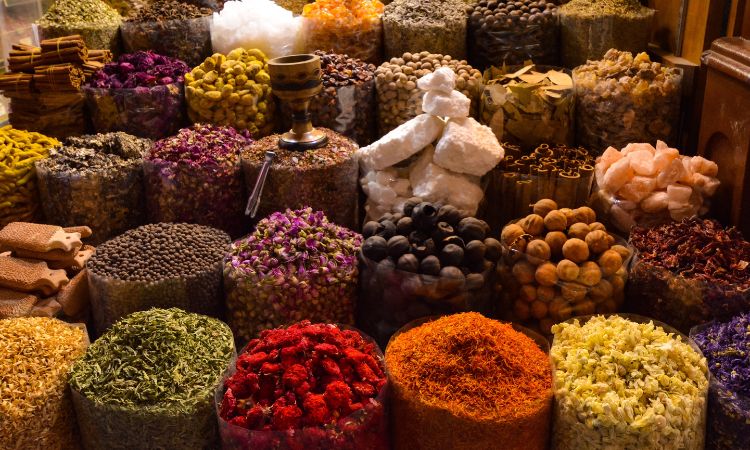The India Spices Market is a vibrant and integral part of the country’s cultural and economic fabric. Known as the world’s largest producer, consumer, and exporter of spices, India plays a pivotal role in meeting the global demand for high-quality spices. In 2023, the market reached a value of INR 86,930 crore due to the increased consumption of spices in the domestic market and rising global exports. Key factors contributing to this growth include India’s diverse climatic conditions, which enable the cultivation of a wide variety of spices, along with a growing preference for natural flavors and ingredients.
India Spices Market Size
The size of the India spices market is substantial, driven by its domestic consumption and international demand. As of 2023, the market was valued at INR 86,930 crore. This sector encompasses a vast range of spices, from traditional varieties like turmeric, cumin, and chili to emerging flavors that cater to the evolving palate of consumers. The steady growth in India’s population, coupled with the increasing usage of spices in both households and the food processing industry, has fueled market expansion. By 2032, the market is expected to grow at a CAGR of 9.20%, reaching a projected value of INR 1,91,945 crore.
India Spices Market Share
India’s dominance in the global spice market is unrivaled, accounting for a significant share of global spice production and export. According to estimates, India holds around 45-50% of the global spice trade. This dominance is attributed to the country’s favorable agricultural conditions and rich heritage in spice cultivation. Major players in the Indian spices market, such as Everest, MDH, Badshah Masala, and Patanjali Ayurved, continue to strengthen their presence both domestically and internationally. The retail sector in India plays a crucial role, with branded spices increasingly capturing market share, supported by rising consumer demand for convenience, quality, and consistency.
India Spices Market Trends
The India spices market has seen numerous emerging trends that are shaping its future growth:
- Organic and Natural Spices: With increasing awareness of health and wellness, consumers are gravitating towards organic and natural spice varieties free from pesticides and artificial additives.
- Value-added Products: Spices in the form of blends, powders, and ready-to-cook mixes are gaining popularity, catering to the fast-paced lifestyle of modern consumers.
- Export Growth: India’s spice exports continue to rise, with demand coming from major markets like the US, Europe, and the Middle East. This demand is largely for premium-quality and organic spices.
- Digitalization and E-commerce: With the rise of e-commerce platforms, consumers now have better access to a variety of spice brands and blends, supporting the market’s expansion into new customer segments.
India Spices Market Analysis
The India spices market is influenced by multiple factors contributing to its steady growth. Here is a detailed analysis of the market:
- Demand Drivers: The domestic market is expanding due to the growing middle class and changing consumer preferences toward premium and organic spice products. Additionally, the increasing focus on processed and packaged foods further drives the demand for high-quality spices.
- Export Potential: India’s rich spice diversity and superior quality enable the country to maintain its leadership in global spice exports. Countries with a large Indian diaspora and increasing demand for authentic Indian flavors are key importers of Indian spices.
- Consumer Behavior: Consumers are shifting towards branded and packaged spices due to concerns over hygiene and food safety, which has led to an increase in the market share of organized players like Everest, MDH, and Tata Consumer Products.
- Challenges: Despite its growth, the market faces challenges such as fluctuating raw material prices, climate change impacts, and stringent regulations in export markets regarding pesticide levels and food safety standards.
Get a Free Sample Report with Table of Contents
India Spices Market Segmentation
The Indian spices market can be segmented based on product type, form, and distribution channel:
- Product Type:
- Single Spices: Turmeric, Chili, Cumin, Coriander, Black Pepper, Ginger, Cardamom, etc.
- Blended Spices: Garam Masala, Sambhar Masala, Chicken Masala, Chaat Masala, etc.
- Others: Exotic spice blends and regional variants.
- Form:
- Whole: Spices in their raw form like whole peppercorns, cumin seeds, etc.
- Powdered: Ground spices such as chili powder, turmeric powder, and cumin powder.
- Extracts: Essential oils and oleoresins derived from spices.
- Distribution Channel:
- Supermarkets/Hypermarkets: Major retail outlets that cater to the organized sector.
- Traditional Grocery Stores: Local grocery stores still dominate in rural and semi-urban areas.
- Online Stores: E-commerce platforms have seen rapid growth, especially for premium and niche spice products.
India Spices Market Growth
The growth of the India spices market is poised to accelerate over the next decade, driven by several factors. Rising consumer awareness about the health benefits of various spices has significantly influenced purchasing behavior. The increasing preference for convenience foods and ready-to-use spice mixes has spurred demand for branded spices. Additionally, India’s spice industry benefits from government initiatives aimed at boosting agricultural productivity and promoting exports. The sector’s projected CAGR of 9.20% between 2024 and 2032 reflects robust growth potential, underpinned by both domestic consumption and export opportunities.
Recent Developments and Challenges in the India Spices Market
Recent Developments:
- Innovation in Product Offerings: Companies are focusing on expanding their product lines by introducing organic, preservative-free, and exotic spice variants.
- E-commerce Penetration: The rise of online platforms such as BigBasket, Amazon India, and specialized spice stores has broadened access to high-quality and niche spices.
- Government Support: Initiatives like the Spices Board of India and various export promotion schemes are aiding farmers and producers in improving quality and boosting exports.
Challenges:
- Climate Change: Erratic weather patterns and rising temperatures have impacted spice cultivation, particularly for sensitive crops like cardamom and saffron.
- Price Volatility: The market is susceptible to fluctuations in the prices of raw materials due to changing agricultural yields.
- Stringent Export Regulations: Major importing countries have stringent pesticide residue regulations, which could limit export growth if standards are not met.
Key Players in the India Spices Market
- Everest Food Products Pvt. Ltd.: Known for its wide range of spice powders and masala mixes, Everest is a leading brand in both the domestic and international markets.
- Mahashian Di Hatti Pvt. Ltd. (MDH): MDH has an extensive portfolio of blended spices and single spice powders that are household staples across India.
- Badshah Masala Private Limited: This brand is popular for its rich and aromatic spice blends, catering to both the domestic market and the Indian diaspora abroad.
- DS Group (Catch): The Catch brand offers premium-grade spices with a strong presence in the ready-to-use spice segment.
- Eastern Condiments Pvt. Ltd.: With a strong presence in South India, Eastern Condiments is known for its traditional spice blends.
- Aachi Masala Foods (P) Ltd.: A leading player in the South Indian spice market, Aachi Masala offers a variety of masala mixes and spice powders.
- MTR Foods Pvt. Ltd.: Known for its ready-to-eat meals and spice mixes, MTR Foods has a significant presence in the organized spice market.
- Patanjali Ayurved Limited: This brand has rapidly gained popularity with its focus on natural and Ayurvedic spices.
- Sakthi Masala Private Limited: Specializing in masala powders, Sakthi Masala is another dominant player in the South Indian spice market.
- ITC Limited: ITC’s Aashirvaad range of spices is known for its quality and availability across India.
- Ushodaya Enterprises Pvt. Ltd. (Priya): Priya Foods offers a range of pickles and spices that cater to both traditional and modern tastes.
- Tata Consumer Products Limited: Tata offers a wide range of premium spices, focusing on quality and sustainability.
- Zoff Foods Private Limited: A relatively new player, Zoff Foods offers pure, unadulterated spices and is growing its presence in the market.
- Goldiee Group: Known for its variety of masala mixes, Goldiee Masale is a household name in the Indian spices industry.
- Ashok Masale: A longstanding brand offering a range of masala powders and spice mixes, popular in both rural and urban markets.
- LIFESTYLE FOODS PVT LTD: With a growing presence, this company offers a range of high-quality, premium spice products.
- Others: Numerous regional and local players contribute to the highly fragmented Indian spices market, catering to diverse taste preferences across the country.
Thanks for allowing guest posting https://technonetwork.co.in/




